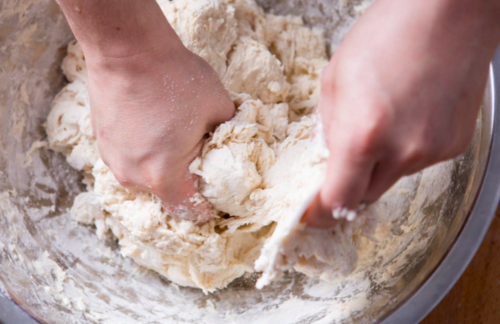We were excited to hold our second Zoom session on a very important topic, the “start” of everything: how to keep your sourdough starter lively and strong. We are offering our sourdough starter here. It is a happy starter, as it’s been very well cared for. It originated in France over 100 years ago, and traveled to Alaska and Taiwan before moving to Menlo Park.
Here are our tips for keeping your starter healthy and happy:
-
Keeping your starter in a mason jar or a plastic container is fine — pretty much any type of lidded container will do. A clear container is fun, because it allows you to see the process of fermentation more clearly. Remember that your starter will triple in volume after feeding, so plan accordingly.
-
Some terminology — you maintain a “starter” and you use that starter to create “leaven” or “levain” which is mixed with flour and water to create your dough. Sometimes these terms are used interchangeably.
-
The 3 critical factors to maintaining a robust starter are time, temperature, and proportions.
-
Time. When should you feed your starter? When is your starter ready to use?
-
Temperature. What temperature water should you use? At what temperature are you storing your starter?
-
Proportions. What proportion of flour to water to use? How much seed starter to keep?
-
-
To this end: get a scale, a thermometer, and a clock. It’s remarkable to me how much these modern instruments are invaluable for identifying the 3 critical factors and measuring the impact they have — they allow you to do in a much shorter time what took years for the apprentice bakers of yore to learn.
-
Time:
-
If you are baking regularly (e.g., once or twice a week), you’ll want to keep your starter on the counter and feed it around the same time every day. Get into a schedule that works for you. A fellow baker friend likes to feed his starter once in the morning and once in the evening, when he is feeding his chickens….
-
At LSB, we typically mix our dough with leaven that is younger and sweeter (less fermented) as we like the more classically “European” flavor of the bread it creates. The longer you let your leaven sit before using it, the more sour your bread will be — which can be great too.
-
-
Temperature:
-
Temperature affects the rate of fermentation. Fermentation is faster at higher temperatures, and slower at lower temperatures. Temperature also affects the flavor profile of your starter and resulting bread: warmer temperatures lead to a “sweeter” profile starter, and a sweeter-tasting bread; cooler temperatures lead to more acidic, paler flavors.
-
A flavorful starter likes to be kept warm! Ideal temperature is around 78-85 degrees. The fridge is a good way to store your starter if you are not baking regularly, but we recommend that you take the starter out and feed it for 3-5 days on the counter before using it if you like a sweeter-tasting, flavorful bread.
-
Don’t freeze your starter. If you need to be away for a long time (months and months), you can actually dry your starter into flakes! Spread a thin layer on parchment paper, allow to dry completely, and store — and revivify with water and flour upon your return.
-
-
Proportions: Here are our preferred proportions for feeding the starter:
-
Take a smidgen of starter (5-10 grams). (Throw away the rest — or you can bake with it if it’s ready!)
-
Add to it 100g of water, at 80-85 F degrees. 100g = roughly 1/2 cup of water
-
Add to that 100g of flour (we like to use 1/2 all purpose and 1/2 whole wheat). 100g = roughly 2/3 cup of flour
-
Mix well.
-
-
Notice that we start with a very small amount of starter to seed our next feed. We much prefer this low percentage of “inoculation” given our particular schedule, environment, and needs, i.e., feeding once a day, ambient temperature of 65-75 F degrees in the winter months, mixing dough 16-18 hours after feeding, and preferring a much sweeter-tasting (less acidic) flavor profile to our breads.
-
You may want to start with this program and then adjust each of the 3 critical factors based on your schedule, environment and needs as you start to learn the daily cycle of your starter. For instance, in the summer, we will be using much colder water (around 50-60 degrees) given that ambient temperatures will be much warmer (70-100 F) but we still need to mix dough 16-18 hours after feeding.
-
Taste your starter at its different stages. Don’t swallow the raw flour (spit it out and rinse your mouth well after!), but smelling and tasting your starter is critical in order to understand fermentation better. You can really get a sense of the flavor of your bread from your starter. If the starter/leaven tastes really sour, that means your bread will be pretty sour. If your starter/leaven has no flavor (i.e., it isn’t ready to use), your bread will have no flavor.
-
A healthy starter is pretty resilient. So if you forget to feed your starter for a couple of weeks and it’s been sitting on the counter, it’s probably still salvageable, even if it’s got a covering of brownish liquid (hooch) on top. Through away all but a smidgen of it, and feed that seed with some fresh flour and water.
More questions than answers at this point? Try a few feeds and then email littleskybakery@gmail.com. Happy Baking!
